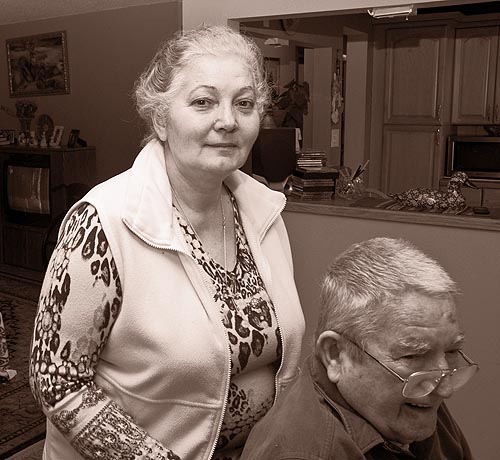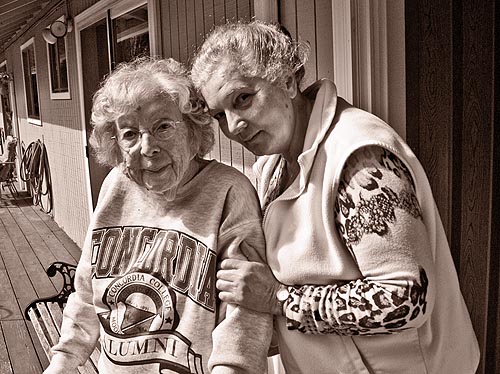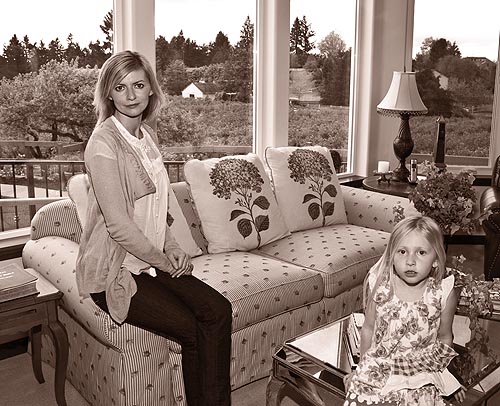How Romanian immigrants cornered the market on adult foster care in Oregon.
 |
Dorina Crainic in the dining room of her Eastmoreland adult foster care home. Crainic’s daughter, Lidia, also runs her own adult foster home in Southeast Portland. |
Dorina Crainic, owner of Dorina’s Adult Care Home in Portland, walks into a bedroom, where an elderly man is trying to put on his shoes.
“How are you, papa?” Crainic asks, wiping saliva from the man’s chin. Battling a urinary tract infection and encumbered by a feeding tube, the man was up much of the night coughing and choking. The evening before, Crainic spent several hours attending to another resident, a woman suffering from dementia.
“There is always something coming up,” she says.
Running an adult foster home, a private residence licensed to provide care for up to five dependent seniors, is physically and psychologically demanding. But the 48-year old Crainic, soft spoken and articulate, isn’t complaining.
In 1992, the former electrical engineer emigrated from Romania, where she and her husband faced religious persecution under the notoriously hard-line communist regime of Nicolae Ceausescu. After working in another foster home for several years, the couple bought their current residence where they care for clients on the first floor and raise two children on the second.
“I’m very happy, very thankful, “ says Crainic. “This is a very good business for us.”
On the surface, Crainic’s story is a familiar one, about hard working immigrants building a successful new life in the United States. But Crainic’s story also spotlights a lesser-known tale about Romanians and how they have cornered the market on adult family homes in the Portland metropolitan area.
Some 85% of the 900 adult foster homes in this region are owned by first- and second-generation Romanians. “They dominate the industry here,” says Grover Simmons, a lobbyist for the Independent Adult Foster Home Association of Oregon.
The story of how Romanians came to control this niche highlights the importance of family networks as the nation and Oregon grapple with the complexities and expenses of health care reform. And as the state’s elder population soars, the Romanian foster-care model offers a compelling example of creative adaptation.
Oregon is “at the forefront” of a larger effort to provide more cost-effective, less institutional alternatives to nursing homes, says Sylvia Reiger, policy analyst for the Oregon Department of Seniors and People with Disabilities.
 |
 |
Felicia Barza, born and raised in Romania, in her Lake Oswego adult foster care home with resident Donald Dickey (top), and Marie Reitan (below) who is turning 101 in July. “This job is 24 hours a day, seven days a week … It’s a good living, but I’m not going to be a millionaire,” says Barza. |
Felicia Barza is sitting at a table in the Lake Oswego foster home she has operated since 2002.
“In Romania, you take care of your mother, your grandmother, your great-grandmother,” the 62-year-old says. “My great- grandmother died in my arms when I was 7. I was so proud.”
The former director of an auto parts warehouse in Transylvania, Barza landed in Anaheim in 1993, where her daughter had emigrated a few years earlier. “Then somebody told me about foster homes in Portland,” she recalls. “I thought the best thing was to be a caregiver because then I [spoke no] English.”
Adult foster care is a relatively small and unknown entity in the long-term adult care industry, and there is a dearth of statistics indicating the size and demographics of the Oregon market. In 2008, foster homes served about 4,000 of the state’s 27,000 long-term-care Medicaid clients, a sector valued at about $1.1 billion. Another 5,000 foster-care residents pay out of pocket, and many homes serve both Medicaid and private-pay clients.
Unlike nursing homes, adult family dwellings are real houses in residential neighborhoods, often modified with additional rooms, baths and safety features. Although most foster-care providers are not medical professionals, each home is assigned a nurse who delegates tasks such as dispensing medication.
In Oregon, the state regulates the industry, with the exception of Multnomah County, where the county wields jurisdiction. Regulators issue licenses to foster-care operators based on the level of care they have the training and experience to provide.
At Felicia’s Adult Care Home, Barza attends to five seniors who need help in almost all aspects of daily living: eating, toileting, bathing and behavior management. With the help of a live-in assistant — a Romanian man who grew up in a Transylvanian monastery — Barza also cleans house, does laundry and cooks three meals daily, including native specialties such as chicken paprikash.
Then there is the constant stream of people — case managers, social workers and family members — going in and out her door.
“This job is 24 hours a day, seven days a week,” says Barza. “It’s a good living, but I’m not going to be a millionaire.”
In an era of skyrocketing health care costs, relative affordability is one of the foster-care industry’s key selling points. Nursing homes cost about $7,500 a month; foster care, by contrast, runs about $3,500 to $5,000.
Medicaid reimbursement rates reflect a similar divide. The state pays about $6,500 per month for nursing home care and $1,800 for foster care. The cost differential is a source of aggravation for foster-care operators, who believe Medicaid compensation for their services should be higher. But the lower reimbursement rates also mean Oregon saves hundred of millions of dollars by placing Medicaid clients in foster homes instead of nursing facilities.
This year, there are 2,755 Medicaid residents in adult foster care. That saves the state about $158 million, according to an analysis by the Oregon Department of Aging and Disability Services.
But the inherent challenges of caring for the elderly day and night can also lead to complications and complaints. In 2009, there were 700 complaints registered against adult foster homes, including rule violations and allegations of abuse; 27% of those allegations were substantiated. In nursing home and assisted- living facilities, by comparison, about 33% of the total allegations were substantiated.
To understand how Romanians came to dominate the public and private foster-care markets, start with the community’s unique set of assets. The first-generation Romanian refugees who immigrated to Portland seeking religious freedom were well educated, with doctors, engineers and business people among the ranks. Their language is also of Latin origin; unlike Laotian and Ethiopian refugees, Romanians didn’t have to learn a new alphabet.
 |
Lidia Pap, with daughter Ellise Pap, age 4, in the family’s adult foster care home in Wilsonville. Pap is a second-generation care provider whose facility is on a blueberry farm. |
Other transferable skills have helped the Romanians succeed. Raised in a communist country noted for its economic and political hardships, the Romanian émigrés share a history of depending on family and friends. Those shared values have proved useful in building a family-based, community care industry.
Fashionable in black boots and jeans, 36-year-old Lidia Pap is a good example of the Romanian foster-care network as well as second-generation provider trends. She learned the business growing up in her parents’ adult foster home and now owns her own residence, Just Like Home, on a blueberry farm in Wilsonville, one of a growing number of luxury foster homes springing up in the suburbs.
Pap is married to a Romanian man in the construction industry, a handy profession when you’re remodeling a house to accommodate a licensed care facility, she notes. The family lives in a separate wing with their three children — another asset in the world of senior care. “The residents love to watch them play,” Pap says. An assistant lives on the premises.
Marketing her business is another collaborative effort, says Pap, who recently partnered with six other second-generation providers on a collective brochure and website. “It unites us,” she says.
Home grown networks gave Romanians a head start in the marketplace. So did public policy trends. In 1981, Oregon became the first state in the country to allow Medicaid waivers to pay for community-based alternatives to nursing homes. A few years later, lawmakers passed legislation allowing nurses to delegate nursing tasks to non-medical service providers.
The pioneering legislation gave dependent seniors the option of living in homelike, non- medical settings and helped build adult foster care as a “fresh industry,” says Simmons.
Enter the Romanians, who had come to the right state at the right time.
One man in particular looms large.
In the late 1970s, Nicky Pop immigrated to Portland, part of the first significant wave of Romanians fleeing Ceausescu. Pop eventually founded the Philadelphia Romanian Pentacostal Church in Southeast Portland.
In the 1980s and 1990s, he sponsored over 16,000 Romanian refugees, helping establish Portland as one of the four biggest Romanian communities in the country. Today, the church is another example of how enmeshed the foster care business is in the Romanian community. It serves as the gathering space for the monthly meetings of the Independent Adult Foster Home Association.
Pop, who is still the church pastor, also owned a foster care home for many years.
Such is the nature of immigrant business development, observes Elizabeth Radulescu, an employment counselor at the Immigrant and Refugee Community Organization (IRCO) and a Romanian herself. “One or two people start something, then everybody else goes in that direction.”
Public and private agencies also played a role. Multnomah County’s Department of Aging Services offered the Romanian arrivals English classes. Senior placement agencies distributed American cookbooks “to teach them how to do a meatloaf,” says Monika Gartner, owner of Care Service Options.
Then there was Orvalee Farris, an American nurse who opened one of the state’s first foster homes in 1979 and eventually trained “hundreds of Romanians,” she says. “I heard about the plight of the refugees and met Nicky Pop,” says Farris, adding that she started the foster care after taking her grandmother out of a nursing home, attracting the interest of a state delegation.
Three decades later, the Romanians largely control the market, with a reputation for stellar home cooking and houses so spotless “you don’t want to touch anything, ” says Amie Clark, owner of the Senior Resource Network.
It’s the kind of success that boosts an entire community. Today, the Romanian per household gross income is relatively high compared to other refugee communities, with some families earning more than $100,000 a year, says Radulescu. Foster care providers have also helped fund about 10 Romanian churches statewide, which cater to the majority Pentecostal and minority Orthodox populations.
It remains to be seen whether Romanians will retain their hold on the marketplace as a third generation grows up in Portland. Adult foster care also faces increasing competition from corporate-dominated assisted-living facilities, which offer private apartments for dependent seniors, as well as residential care facilities, which often specialize in care for people with Alzheimer’s or dementia.
Regardless, the story of Romanian foster- care providers unfolds as a kind of fable about the U.S. health care system, past and future.
By 2030, the number of people 65 and older is expected to double, with the fastest growth among those over 85. Accommodating a burgeoning senior population requires rethinking a host of issues: the medicalization of the aging process, the enormous costs associated with long-term care institutions and the tendency to devalue jobs that involve caring for vulnerable and dependent populations.
The success of the adult foster-care model as practiced by the local Romanian community showcases a refreshing Old World alternative to the New World issues facing the nation’s health care system. A network of relatively affordable commercial residences, staffed by small business owners, has cut costs without sacrificing quality.
It may not be the only solution, but health care reform going forward likely will require hundreds of such small-scale initiatives and experiments.
Oregon pioneered the idea of licensing home-based care environments, but it took a group of church-going, back-to-basics Eastern European émigrés to make that vision a reality.


